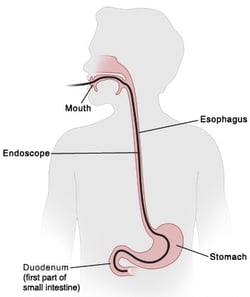Your child has been scheduled for an Endoscopy at Children’s Wisconsin Hospital in Milwaukee on (date) _________________ at (time) __________________.
When you get to the hospital, stop at a Welcome desk for a badge and directions.
What is an endoscopy? 
An Endoscopy (EGD) is a test that lets the doctor see the inside of the esophagus, stomach and small intestine.
How is it done?
Your child will be asleep during the test. A soft, flexible tube goes in the mouth and down to the stomach. Once the tube is in, the doctor can look at the lining of the esophagus, stomach and duodenum on a TV monitor. Small samples of tissue called biopsies may be taken to the lab to be looked at.
Before the test
1. Your child must not eat any solid food or drink any non-clear liquids after midnight. Clear liquids are okay up to 2 hours before the test.
What is considered a clear liquid?
- White grape juice
- Jell-O®
- Apple juice
- Water
- Gatorade
- Popsicle®
- Kool-Aid®
No milk or dairy products.
No red- or purple-colored liquids. These can stain the esophagus, stomach and make it look bloody.
Please note: It is important that you follow these special instructions. If your child eats or drinks anything after the times listed above, the test may be cancelled.
2. A nurse from Day Surgery will call you 2 to 3 days before the test to:
- Get a brief history.
- Check the current health of your child. Your child should not have a fever, cold or other illness.
- Remind you what time your child must stop eating and drinking.
- Tell you what time to come to the hospital. Please remember, the time you were given when the test was scheduled is only an approximate one. The schedule can change at any time. The majority of tests will occur on time.
3. If your child has diabetes or other health problems, please contact your doctor or clinic about this test as soon as it is scheduled.
After the test
When the endoscopy is done, your child will go to the Recovery Room for a short time. Your child will then go back to Day Surgery. Your child can go home when they are awake and alert. This may take several hours.
The results of the biopsies will be ready in about one week. A member of your child’s health care team will call you with results. Call after one week if you have not heard from the doctor.
Possible risks
An allergic reaction to anesthesia or medicine can occur. The scope (tube) could make a hole in the intestine or bleeding may occur. If this happens, surgery may be needed. Infections such as pneumonia may occur following anesthesia. These risks are rare.
- If you need to cancel the test, call the GI Clinic at (414) 266-3690, Mon – Fri.
- If it is the day of the test and you have questions about the time of the test or your child’s health, please call Day Surgery at (414) 266-3536, Mon – Fri.



